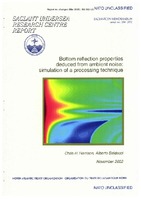| dc.description.abstract | A promising new method has already been proposed [SACLANTCEN SM-387] to calculate bottom reflection loss from ambient noise directionality. Although this method has been tried experimentally at more than 11 sites under various conditions, it is difficult to explore its limitations exhaustively by experiment. In these cases numerical testing is much more straightforward. For example, array tilt, array curvature, and varying sound speed along the array are relatively easy to model. Numerical techniques are useful in eliminating contending effects and homing in on the correct one. They also provide a second opinion on the theoretical background of the experimental technique, and throw light on, for instance, the feasibility of using a drifting array as a bottom surveying tool. This report attempts to quantify problems such as these. | |
